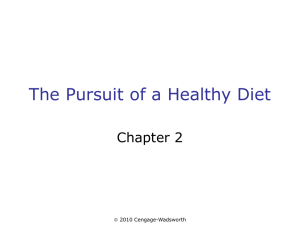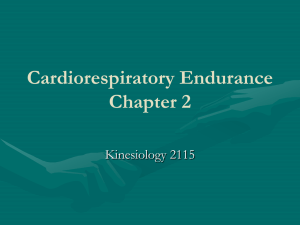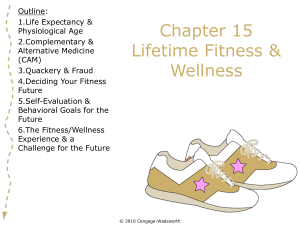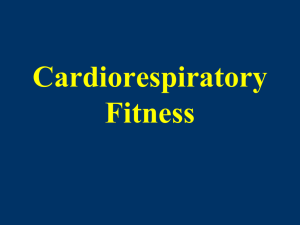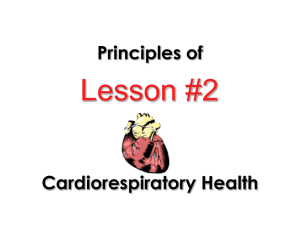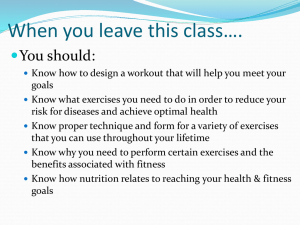Chapter 6 - evaluations
advertisement
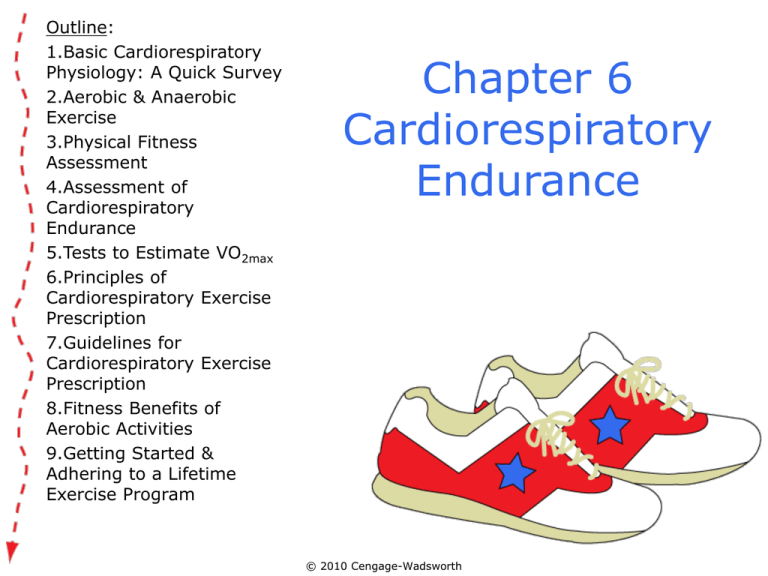
Outline: 1.Basic Cardiorespiratory Physiology: A Quick Survey 2.Aerobic & Anaerobic Exercise 3.Physical Fitness Assessment 4.Assessment of Cardiorespiratory Endurance 5.Tests to Estimate VO2max 6.Principles of Cardiorespiratory Exercise Prescription 7.Guidelines for Cardiorespiratory Exercise Prescription 8.Fitness Benefits of Aerobic Activities 9.Getting Started & Adhering to a Lifetime Exercise Program Chapter 6 Cardiorespiratory Endurance © 2010 Cengage-Wadsworth 1 2 3 4 5 6 7 8 9 Cardiorespiratory Endurance • Cardiorespiratory endurance: The ability of the lungs, heart, and blood vessels to deliver adequate amounts of oxygen to the cells to meet the demands of prolonged physical activity • The single most important component of health-related physical fitness • Aerobic exercise is important in preventing cardiovascular disease © 2010 Cengage-Wadsworth 1 2 3 4 5 6 7 8 9 The epitome of physical inactivity: driving around a parking lot for several minutes in search of a parking spot 20 yards closer to the store’s entrance • Technological developments have driven most people in developed countries into sedentary lifestyles © 2010 Cengage-Wadsworth 1 2 3 4 5 6 7 8 9 Cardiorespiratory Endurance • Hypokinetic diseases – “Hypo” means low or little, and “kinetic” implies motion • One of the most harmful effects of modern-day technology is an increase in chronic conditions related to a lack of physical activity such as hypertension, heart disease, chronic low back pain, obesity © 2010 Cengage-Wadsworth 1 2 3 4 5 6 7 8 9 Advances in modern technology have almost completely eliminated the need for physical activity, significantly enhancing the deterioration rate of the human body © 2010 Cengage-Wadsworth 1 2 3 4 5 6 7 8 9 Basic Cardiorespiratory Physiology: A Quick Survey • Cardiorespiratory endurance is a measure of how the pulmonary (lungs), cardiovascular (heart and blood vessels), and muscular systems work together during aerobic activities • As a person breathes, part of the oxygen in the air is taken up by the air sacs (alveoli) in the lungs • As blood passes through the alveoli, oxygen is picked up by an iron-containing compound (hemoglobin) and transported in the blood to the heart • The heart pumps the oxygenated blood through the circulatory system to all organs and tissues of the body © 2010 Cengage-Wadsworth 1 2 3 4 5 6 7 8 9 Basic Cardiorespiratory Physiology: A Quick Survey • Adenosine triphosphate (ATP) – a highenergy chemical compound that the body uses for immediate energy • Oxygen is used to convert food substrates (carbohydrates and fats) through aerobic metabolism into ATP • ATP provides the energy for physical activity, body functions, and maintenance of constant internal equilibrium • During physical exertion, the lungs, heart, and blood vessels have to deliver more oxygen to the muscle cells to supply ATP © 2010 Cengage-Wadsworth 1 2 3 4 5 6 7 8 9 Cardiorespiratory endurance refers to the ability of the lungs, heart, and blood vessels to deliver adequate amounts of oxygen to the cells to meet the demands of prolonged physical activity © 2010 Cengage-Wadsworth 1 2 3 4 5 6 7 8 9 Basic Cardiorespiratory Physiology: A Quick Survey • Oxygen uptake (VO2): Amount of oxygen consumed by the body • Maximal oxygen uptake (VO2max): Maximum amount of oxygen the body is able to use per minute of physical activity, expressed in L/min or mL/kg/min; the best indicator of cardio-respiratory or aerobic fitness • A high capacity to deliver and utilize oxygen indicates a more efficient cardiorespiratory system • A low level of endurance indicates the heart has to work harder, less oxygen is delivered to the tissues, and the individual fatigues faster • Measuring oxygen uptake is a way to measure cardiorespiratory health © 2010 Cengage-Wadsworth 1 2 3 4 5 6 7 8 9 Aerobic & Anaerobic Exercise • Aerobic exercise: Exercise that requires oxygen to produce the necessary energy (ATP) to carry out the activity – Walking, jogging, swimming, cycling, cross-country skiing, water aerobics, rope skipping, and aerobics • Anaerobic exercise: Exercise that does not require oxygen to produce the necessary energy (ATP) to carry out the activity – Track and field (100, 200, 400 meters), swimming (100 meters), gymnastics routines, strength training • Only aerobic activities will increase cardiorespiratory endurance © 2010 Cengage-Wadsworth 1 2 3 4 5 6 7 8 9 Aerobic & Anaerobic Exercise © 2010 Cengage-Wadsworth 1 2 3 4 5 6 7 8 9 Benefits of Aerobic Training • Higher maximal oxygen uptake • Increase in the oxygen-carrying capacity of the blood • Decrease in resting heart rate (about 110-20 bpm) and an increase in cardiac muscle strength • Resting heart rate – Heart rate after a person has been sitting quietly for 15-20 minutes • Cardiac output – Amount of blood pumped by the heart in one minute • Stroke volume – Amount of blood pumped by the heart in one beat © 2010 Cengage-Wadsworth 1 2 3 4 5 6 7 8 9 Benefits of Aerobic Training • Lower heart rate at given workloads • Increase in number and size of the mitochondria • Increase in the number of functional capillaries © 2010 Cengage-Wadsworth 1 2 3 4 5 6 7 8 9 Benefits of Aerobic Training • Faster recovery time • Lower blood pressure and blood lipids • An increase in fat-burning enzyme © 2010 Cengage-Wadsworth 1 2 3 4 5 6 7 8 9 Physical Fitness Assessment • Reasons to assess physical fitness – To educate participants regarding present fitness levels and compare them to health fitness and physical fitness standards – To motivate individuals to participate in exercise programs – To provide a starting point – To evaluate improvements achieved through exercise programs and make adjustments – To monitor changes in fitness throughout the years © 2010 Cengage-Wadsworth 1 2 3 4 5 6 7 8 9 Responders vs. Nonresponders • A wide variation in physiological responses exists between individuals who follow similar training programs • Heredity plays a crucial role in how each person responds and improves following an exercise program • Principle of individuality: – Studies have documented that some individuals readily experience improvements in fitness (responders), whereas others exhibit small or no improvements at all (nonresponders) following similar exercise training programs © 2010 Cengage-Wadsworth 1 2 3 4 5 6 7 8 9 Components of Oxygen Uptake (VO2) • The amount of oxygen the body actually uses at rest or during submaximal (VO2) or maximal (VO2max) exercise is determined by the – heart rate (HR), – stroke volume (SV), – and the amount of oxygen removed from the vascular system (arteriovenous oxygen difference [a-vO2diff]) © 2010 Cengage-Wadsworth 1 2 3 4 5 6 7 8 9 Heart Rate • Maximal heart rate (MHR) that a person can achieve starts to drop by about one beat per year beginning about age 12 • MHR in endurance athletes is sometimes slightly lower than in untrained individuals • This training adaptation is believed to allow the heart more time to effectively fill with blood to produce a greater stroke volume © 2010 Cengage-Wadsworth 1 2 3 4 5 6 7 8 9 Stroke Volume • Stroke volume increases significantly following endurance training • Some of the increase is the result of a stronger heart muscle, an increase in total blood volume, and a greater filling capacity of the ventricles in the resting phase of the cardiac cycle • As more blood enters the heart, more blood can be ejected with each heartbeat • The increase in stroke volume is responsible for the increase in VO2max with endurance training © 2010 Cengage-Wadsworth 1 2 3 4 5 6 7 8 9 Amount of Oxygen Removed from Blood • VO2max is affected by genetics, training, gender, body composition • Only those people with a strong genetic component are able to reach an “elite” level of aerobic capacity • VO2max in men is 15%-30% higher because men have a greater hemoglobin content, lower body fat, and a larger heart • VO2max decreases by about 1% per year starting at age 25; however, it is only 0.5% per year in physically active people © 2010 Cengage-Wadsworth 2 1 3 4 5 6 7 8 Tests to Estimate VO2max • Five tests are used to asses cardiorespiratory fitness – – – – – 1.5-Mile Run 1.0-Mile Walk Step Test Astrand-Ryhming Test 12-Minute Swim Test © 2010 Cengage-Wadsworth 9 1 2 3 4 5 6 7 8 Tests to Estimate VO2max: 1.5-Mile Run Test 9 • Estimates VO2max based on how fast an individual is able to run/walk a 1.5-mile course • Test should be limited to individuals who have been cleared for exercise • Not recommended for unconditioned beginners or men over 45 and women over 55 without medical clearance, symptomatic individuals, and those with risk factors or with coronary heart disease • 6 weeks of aerobic training is recommended prior to testing © 2010 Cengage-Wadsworth 1 2 3 4 5 6 7 8 9 1.0-Mile Walk Test • Can be used by individuals unable to run because of low fitness levels or injuries • Estimates VO2max based on a predicting equation that requires the time it takes to walk a 1.0-mile course, exercise heart rate of at least 120 bpm at the end of the test, body weight, and gender © 2010 Cengage-Wadsworth 1 2 3 4 5 6 7 8 9 Step Test • Requires little time, equipment, and can be administered to almost anyone except those symptomatic and diseased individuals, and significantly overweight individuals with joint problems • Estimates VO2max based on a 3-minute step (16 1/4"-high) test and a 15-second heart rate taken between 5 and 20 seconds into recovery © 2010 Cengage-Wadsworth 1 2 3 4 5 6 7 8 9 Astrand-Ryhming Test • The same cautions for the Step Test also apply to this test except that overweight individuals with limited joint problems can participate • Estimates VO2max based on a 6-minute bicycle ergometer test according to gender, work load, exercise heart rate, age, and body weight Monitoring heart rate on the carotid artery during the Astrand-Ryhming Test © 2010 Cengage-Wadsworth 1 2 3 4 5 6 7 8 9 12-Minute Swim Test • Determines cardiorespiratory fitness category according to the distance swam in 12 minutes • Test should be limited to skilled/ conditioned swimmers • Considered a maximal test, thus medical clearance is recommended Only those with swimming skill and proper conditioning should take the 12-minute swimming test © 2010 Cengage-Wadsworth 1 2 3 4 5 6 7 8 9 Principles of Cardiorespiratory Exercise Prescription • A low percentage of the U.S. population is truly committed to exercise • More than half of the people who start exercising drop out during the first 3 to 6 months of the program • Sports psychologists are trying to find out why some people exercise habitually and many do not © 2010 Cengage-Wadsworth 1 2 3 4 5 6 7 8 9 Readiness for Exercise • To enjoy all the benefits of exercise, you must – Ask yourself if you are ready to start an exercise program – Give it a try © 2010 Cengage-Wadsworth 1 2 3 4 5 6 7 8 9 Guidelines for Cardiorespiratory Exercise Prescription • Only about 19% of adults in the U.S. meet minimum recommendations of the ACSM for the improvement and maintenance of cardiorespiratory fitness • To develop the cardiorespiratory system, the heart muscle must be overloaded to increase in size, strength, and efficiency • Four FITT variables govern exercise prescription: frequency, intensity, type (mode), and time (duration) © 2010 Cengage-Wadsworth 1 2 3 4 5 6 7 8 9 Intensity of Exercise • Intensity: How hard a person has to exercise to improve or maintain fitness • Health and cardiorespiratory fitness benefits occur when the person is working between 40% & 85% of heart rate reserve (HRR) with appropriate frequency and duration • Health benefits occur when training at 40% to 60% for a longer time • Greater improvements in cardiorespiratory fitness occur through a vigorous-intensity program • Training intensity levels for unconditioned to healthy – Low = 40% to 50% – Moderate = 50% to 60% – High = 60% to 85% © 2010 Cengage-Wadsworth 1 2 3 4 5 6 7 8 Intensity of Exercise • Low-intensity training zone: 121 to 134 bpm • Moderate-intensity training zone: 134 to 147 bpm • High (optimal) training zone: 147 to 180 bpm © 2010 Cengage-Wadsworth 9 1 2 3 4 5 6 7 8 9 Recommended cardiorespiratory or aerobic training pattern • To improve your cardiorespiratory fitness, maintain your heart rate between the 60% and 85% training intensities © 2010 Cengage-Wadsworth 1 • • • • 2 3 4 5 6 7 8 Physical activity perceived exertion (H-PAPE) scale Rate of perceived exertion (RPE): A perception scale to monitor or interpret the intensity of aerobic exercise You have to associate your own inner perception of the task with the phrases given on the scale Cross check your target zone with your RPE during the first few weeks of your program After several weeks, you should be able to predict your exercise heart rate just by your own perceived exertion of the intensity of exercise © 2010 Cengage-Wadsworth 9 1 2 3 4 5 6 7 8 9 Mode of Exercise • • • • • • • • Mode: Form or type of exercise that builds the cardiorespiratory system must be aerobic in nature Maintain heart rate in the proper training zone during exercise Examples are walking, jogging, stair climbing, elliptical activity, aerobics, swimming, water aerobics, cross-country skiing, rope skipping, cycling, racquetball, stationary running or cycling It must involve the major muscle groups and be rhythmic and continuous It should be based on your preferences--what you enjoy--and your physical limitations Low-impact activities greatly reduce the risk for injuries and will yield health benefits Higher-impact activities will improve the high physical fitness level Always use the same exercise mode for testing and training © 2010 Cengage-Wadsworth 1 2 3 4 5 6 7 8 9 Cross-country skiing requires more oxygen and energy than most other aerobic activities © 2010 Cengage-Wadsworth 1 2 3 4 5 6 7 8 9 Duration of Exercise • Duration: Time or length of each exercise session • General recommendation = 20 to 60 minutes per session • Based on the intensity level • Training at about 85% = 20 to 30 minutes • Training at 50% = 30 to 60 minutes • Accumulating 30 minutes of moderate-intensity physical activity also provides benefits; three 10minute sessions throughout the day produce benefits © 2010 Cengage-Wadsworth 1 2 3 4 5 6 7 8 9 Duration of Exercise • For weight management, 60 minutes of physical activity on most days of the week are recommended • To prevent weight regain, 60-90 minutes of physical activity on most days of the week are recommended • If lack of time is a concern, exercise at vigorous intensity for 30 minutes • Exercise session should be preceded by a 5- to 10-minute warm-up and be followed by a 10-minute cool-down © 2010 Cengage-Wadsworth 1 2 3 4 5 6 7 8 9 Frequency of Exercise • Frequency: How many times per week a person engages in an exercise session • Recommended = 3 to 5 days per week • When exercising at 60%-85% of HRR, three 20- to 30minute sessions on nonconsecutive days is sufficient to improve or maintain VO2max • Training at a lower intensity requires 30-60 minutes more than three days a week • Further VO2max improvements are minimal when training is conducted more than 5 days per week • For health benefits, accumulate 30 minutes of moderateintensity physical activity on most days of the week • For weight loss, 60-90 minutes of low- to moderateintensity exercise on most days of the week © 2010 Cengage-Wadsworth 1 2 3 4 5 6 7 8 Cardiorespiratory exercise prescription guidelines © 2010 Cengage-Wadsworth 9 1 2 3 4 5 6 7 8 9 The Physical Activity Pyramid © 2010 Cengage-Wadsworth 1 2 3 4 5 6 7 8 9 Physically challenged people can participate and derive health and fitness benefits through a high-intensity exercise program © 2010 Cengage-Wadsworth 1 2 3 4 5 6 7 8 9 Ratings for Selected Aerobic Activities © 2010 Cengage-Wadsworth 1 2 3 4 5 6 7 8 9 Getting Started & Adhering to a Lifetime Exercise Program • Once you have determined your exercise prescription, the difficult part begins: starting and sticking to a lifetime exercise program • Lifelong dedication and perseverance are necessary to reap and maintain good fitness • Soon you will develop a habit of exercising that will bring about a sense of selfaccomplishment © 2010 Cengage-Wadsworth 1 2 3 4 5 6 7 8 9 A Lifetime Commitment to Fitness • The benefits of fitness can be maintained only through a regular lifetime program • Time involved in losing exercise benefits varies among the fitness components and also depends on the person’s condition before the interruption • 4 weeks of aerobic training are completely reversed in 2 consecutive weeks of inactivity unless you have been exercising regularly for months or years • As a rule, after 48-72 hours of aerobic inactivity, the cardiorespiratory system starts to lose some of its capacity © 2010 Cengage-Wadsworth 1 2 3 4 5 6 7 8 9 A Lifetime Commitment to Fitness • To maintain fitness, exercise regularly even during vacations • If you have to stop your exercise program do not attempt to resume training at the same level you left off; build up gradually • If the greatest athletes on earth stopped exercising, they would be, after just a few years, at about the same risk for disease as someone who has never done any physical activity • Staying with a physical fitness program long enough brings about positive physiological and psychological changes © 2010 Cengage-Wadsworth 1 2 3 4 5 6 7 8 9 Cardiorespiratory exercise record form © 2010 Cengage-Wadsworth
